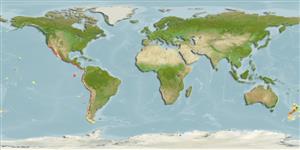Teleostei (teleosts) >
Anguilliformes (Eels and morays) >
Congridae (Conger and garden eels) > Congrinae
Etymology: Gnathophis: Greek, gnathos = jaw + Greek, ophis = serpent (Ref. 45335).
More on author: Garman.
Environment: milieu / climate zone / depth range / distribution range
Ecology
Marine; demersal; depth range 9 - 366 m (Ref. 96339). Tropical; 37°N -
Eastern Pacific: southern California, USA to Peru.
Size / Weight / Age
Maturity: Lm ? range ? - ? cm
Max length : 42.0 cm TL male/unsexed; (Ref. 2850)
A soft bottom inhabitant. Reported to burrow into loose sand, and appears to be fairly resistant to chemical preparations used for collecting fish (Ref. 2850). Bottom feeding predators devour conger eels when encountered in the open (Ref. 4525).
Life cycle and mating behavior
Maturity | Reproduction | Spawning | Eggs | Fecundity | Larvae
Smith, D.G., 1995. Congridae. Congrios. p. 1026-1035. In W. Fischer, F. Krupp, W. Schneider, C. Sommer, K.E. Carpenter and V. Niem (eds.) Guia FAO para Identification de Especies para lo Fines de la Pesca. Pacifico Centro-Oriental. 3 Vols. FAO, Rome. (Ref. 9292)
IUCN Red List Status (Ref. 130435: Version 2024-1)
Threat to humans
Harmless
Human uses
Tools
Can't connect to MySQL database fbquizv2. Errorcode: Too many connections
